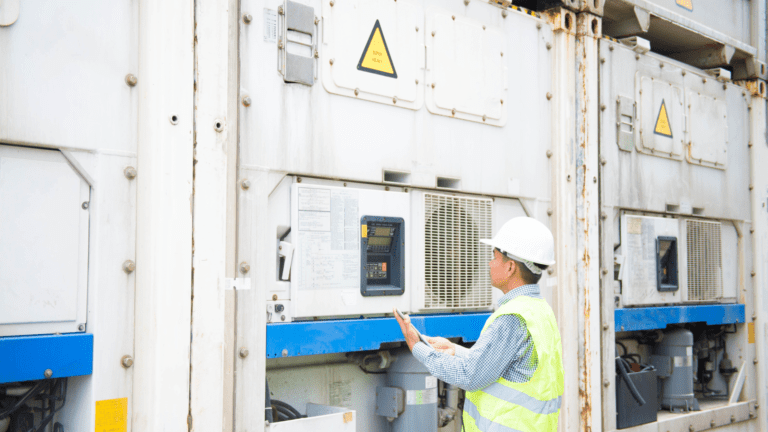 The container refrigeration unit – also known as the “reefer” – is one of the most important aspects of the modern food supply chain. As food often has to travel hundreds of miles to its final destination, it’s the reefer that enables producers and sellers to work together effectively.
The container refrigeration unit – also known as the “reefer” – is one of the most important aspects of the modern food supply chain. As food often has to travel hundreds of miles to its final destination, it’s the reefer that enables producers and sellers to work together effectively.
Reefer units are also widely used in the marine setting so cargo ships can maintain refrigeration. The reefer used for seaborne cargo requires an external power supply. It must stand up against changing conditions in the sea and the potential for harsh weather before getting to its destination.
How Do Reefer Containers Operate in a Marine Vessel?
When a reefer container is loaded onto a ship, it draws power from the diesel generator of the vessel. If it can’t be supplied from this source, mobile power packs are installed to make up the difference. This may be necessary when you have an older vessel with reduced generator capacity.
Three main types of reefer containers are in use:
1. Closed Reefer
The closed reefer is the conventional model used most often. It is a single piece with an integral front wall. The combined heating and cooling unit installed within the reefer is suitable for all ISO-compliant seagoing containers.
2. Modified/Controlled Atmosphere (MA/CA)
These more advanced container units are distinguished by enhanced insulation. They create a consistent interior environment by replacing consumed oxygen via a specialized air exchange controller. This ensures the environment matches cargo specifications throughout the journey.
3. Automatic Fresh Air Management Containers (AFAM)
You can think of AFAM as an upgrade to MA/CA containers. These are the most sophisticated reefer containers available today. They regulate the air combination by using an array of sensors to adjust the fresh air exchange rate. By precisely controlling oxygen and carbon dioxide, they can extend cargo shelf life.
Major Parts of the Reefer Container Unit
If you are familiar with the basic parts of a commercial refrigeration system, the key components of a reefer come as no surprise. Because of their operating environment, however, the implementation must take into account the greater risk of mechanical stress and voltage inconsistencies.
The main parts of the reefer are:
1. Compressor Section
This section consists of the compressor and power cable storage compartment, with an optional power transformer setup if needed by the ship’s supply. It is equipped with specialized valves for optimizing gas flow. In addition to standard safety fittings, many reefer containers now have full electronic sensors that monitor compressor suction and discharge and supply air temperature.
2. Condenser Section
The condenser section holds the condenser motor and fan, an air-cooled condenser coil, and a sensor for condenser saturation levels. Air is typically pulled from the bottom, passing through the unit’s center before being discharged horizontally. Although water-cooled units are available, they are not necessary for most applications – and require a substantial budget.
3. Evaporator Section
The evaporator section has become complex in recent years. It uses a variety of sensors, including the temperature reading bulb, return recorder, and a TXV. The unit itself consists of the evaporator coil and heater and supporting components. The evaporator fan pulls air from the top of the refrigeration unit, circulates it, and directs it through the evaporator coil.
Reefer Container Malfunctions and Maintenance
It’s no surprise a reefer container unit should be thoroughly inspected before and after use to ensure it is in operating condition. Just like other commercial refrigeration systems, it’s crucial to ensure your compressor unit is in working order.
As important as the compressor is, all other problems within that unit are dwarfed by leakage. Leakage of refrigerant is by far the most common reefer container issue. Onboard personnel should conduct periodic tests to detect leaks. Options for leak detection include:
1. Low-Pressure Soapy Water Test
This check is performed on a low-pressure line by lightly coating soapy water onto the pipe suspected of leaking. Bubbles will form on the water if it coats an area with an active leak.
2. Electronic Leak Detector
Portable leak detector units may be used aboard ship to quickly isolate leaks. However, these devices can be affected by other electrical systems around them, so they are not always 100% reliable on their own.
3. On-Board Leak Detector
A growing number of reefer containers have a fixed leakage detection system complete with alarm.
A halide lamp test can also be performed by making a small hole in the insulation of the suspected pipe and performing a visual inspection. If leakage is confirmed, insulation can be removed from the pipe section to pinpoint the source of the problem.
About $4 trillion in cargo goes to sea every year, and much of it depends on reefer containers. With this information and your knowledge of refrigeration, you can select the right reefers and keep them going with the right industrial compressor.












